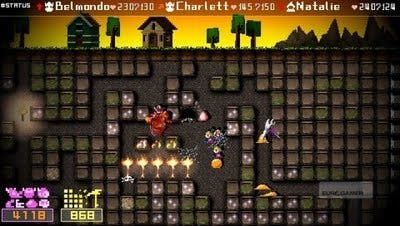Holy Invasion of Privacy, Badman! What Did I Do to Deserve This?
Dwarf Fortress.
The game's stages work more like rounds, as the dungeon you build for yourself remains a constant from invasion to invasion. As such, any mistake you make early in the game in, for example, creating too large a chamber to shepherd your Slimemoss around effectively, is both un-rectifiable and ever-present, at least until the heroes get the better of you and the game's finished. To encourage thoughtfulness, the game forces frugal use of your pickaxe. Each round you're given a limited number of dig points with which to hollow out the earth and, as the game's only currency, any remaining dig points you have at the end of the round can be spent on upgrading each type of creature in the dungeon. Balancing the creation of a complex large enough to hide Badman against holding back enough points to ensure you can level your army in between rounds is a constant consideration.
There's no denying that Badman's ideas are intriguing, and feeling the boundaries and limitations of any novel game idea is always enjoyable. However, the game's overreliance on the AI of your individual creatures creates just too much of a disconnect between game and player. Every unit, from the lowliest Slimemoss to the most fearsome dragon, behaves on its own terms and, other than creating the corridors that shepherd them around your dungeon, they will not be directed in any way. This is often frustrating, as you'll have good and able defensive units but discover they're roaming some distant corner of your dungeon while the intruding heroes hack and slash their way towards Badman unimpeded. As units feed on one another as in a real food chain, a crack unit can be consumed when you want it to remain part of the team, and when dungeon pockets are crawling with friendly units it can be impossible to make out what's going on.

Elsewhere, the game's tutorials (which act more like standalone puzzles in themselves, and often lack the clearness of instruction that they should, by definition, be doling out) emphasise the importance of considering the internal structure of your dungeon, but they offer only the slightest hint as to what a good dungeon layout might be and, even when you follow these directions to the letter, the results are often far from positive or consistent. Even as you begin to work your way through the Challenge stages, and the game's deeper strategies and tactics reveal themselves, those basic fundamentals never quite shift into focus, ensuring that no matter how advanced your strategy, it's always muddied by basic inconsistencies.
The game's peppered through with the sort of idiosyncratic humour that marks so many of Nippon Ichi's games, but here the jokes often come at the expense of clarity, with Badman more eager to poke fun at some crusty JRPG convention than to properly explain his game's own subversions. As such, the game offers the worst sort of challenge: one that's tall yet vague and indistinct, leading to frustrations and failures that are oftentimes impossible to learn from. Despite all this, Nippon Ichi's designers are onto something, and the germ of the idea undeniably has potential. For the confirmed sequel, they'll need to provide players with far more of a sense of control and direction if the game's to blossom into the potential shown here.

